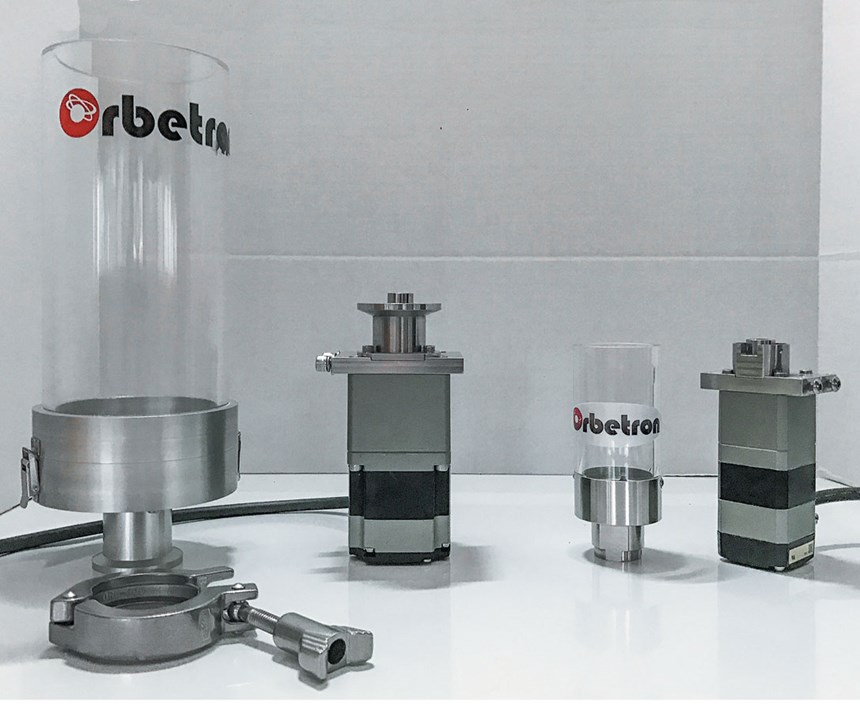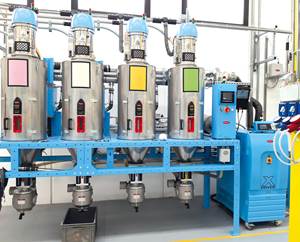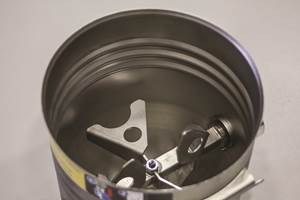Understanding Low-Rate Feeding for Continuous and Batch Processes
Molders and extruders that need to feed tiny amounts of material to their process require precision in both the material being fed and the equipment doing the dosing. When a shot size consists of three pellets, there is no margin for error.
Perhaps now more than ever, processors are being driven by their customers to maintain extremely tight color tolerances, use only a very specific amount of additives, and comply with additional requirements such as documentation. This has given rise to new feeding technology that can deliver material at extremely low rates. While low-rate feeding itself is not new, processors previously had asked their material suppliers to carry the burden of putting these components together, putting colors and certain additives into a single pellet. But as product requirements change, processors want the flexibility to add minor ingredients separately in order to make short runs, reduce cost to be more competitive, and customize the product to fit their customers’ changing needs. A large part of this is being driven by the medical industry, which has made processors in both injection molding and extrusion look at new ways they can feed these minor ingredients at low rates and maintain consistency.
When considering equipment for low-rate feeding in your injection molding or extrusion process, understanding your material (whether pellets or powder) and how it should be fed into your process is crucial. By reviewing the points below, you can determine whether your material is capable of being fed at the desired low rates to ensure consistent and repeatable feeding.
For the purposes of this article, “micro feeding” is defined as dosing materials from 200 g/hr (0.44 lb/hr) down to 1 g/hr (0.0022 lb/hr). Many processors wonder why it is critical to understand the material when feeding at low rates. The simple answer is that your material varies in shapes and sizes, which can affect feeding accuracy and consistency.
Let’s start by reviewing the material considerations and define some basic points. In most molding applications we feed pellets; in extrusion applications we can feed both pellets and powder.
WHAT IS YOUR MATERIAL TYPE?
Some general information to know about your material would be its bulk density (lb/ft3); flowability (free flowing, fairly free flowing, or poorly flowing); and particle size or sizes. Do you have an accuracy requirement for these properties, and can it be achieved?
In the case of pellets, look at the pellet shapes (square, round, flat, cylindrical, etc.). Consistency of the pellet size and shape is a very important factor to ensure repeatability of your feeder. Medical-grade materials generally tend to be the most consistent in terms of pellet size and shape, while lower-cost materials tend to have more fines and varied sizes of pellets. When considering low-rate feeding, processors should make sure their material supplier can supply both clean and consistent material sizes.
In the case of powdered materials, particle size and output volume are generally consistent. That said, the flowability of the material can have the greatest impact on accuracy. It is common practice for feeders that handle cohesive or poorly flowing material to incorporate flow aids to overcome material inconsistency. These flow aids can come in both mechanical and software-based solutions. These flow aids are typically defined during the supplier’s testing program.
WHAT IS YOUR MATERIAL FEED RATE?
Most processors define feed rates for additives as a percentage of the overall weight. Consider the example of a small-tonnage medical molding application feeding color to produce a translucent product. In this scenario, a shot size of 1.68 g with a color additive of 0.06 g was equal to three pellets. This example should make it crystal clear why it is so important to understand material inconsistency. If the variation of the pellet was too great, the molder could not hold product color consistently. Due to the translucency of the product, feeding two or four pellets would make a difference in the end-product’s color shade.
The output from the feeder had to be a consistent three pellets. Our lab testing did find some variations of pellet sizes in different batches of colors. After some feeding tests, we were able to overcome these minor variations with some feeder modifications and produce a product with consistent color.
Feeding materials at higher rates typically mitigates a number of inconsistencies that standard materials have. During testing of different batches of materials, feeding under 100 g/hr, we have found that small changes in pellet sizes can have a significant impact on the feeder output. Example: Feeding a cylindrical pellet using a hole size of 3/16 in. would feed two to three pellets into the process, but using a 5/32-in. hole would feed one to three pellets.
The example above shows that weight is important to establish your basis, but the actual micro-feeder volume output design (feeding three pellets) will have a greater impact on your true product consistency at low rates. This is the major reason material consistency is so crucial for feeding low rates.
FEEDING INTO THE PROCESS
Once the material type, expected rate, and the process have been defined, you can now establish a building block for the feeder type that will feed into the process. Most low-rate applications are being fed into small-tonnage molding machines and small extruders of 0.75-in. to 2-in. diam.
Incorporation of the feeder into the extruder requires some general review and consideration. Testing has shown that feeding the pellet or powdered materials as close to the feedscrew as possible will provide the best results. Avoid feeding additives into the stream of virgin material, as this may result in delays in getting the color started into the process and result in possible dispersion inconsistencies.
An additional advantage of feeding the material as close to the extruder screw as possible is that this makes it easier to accomplish material changeovers with minimal downtime.
WHAT TYPE OF FEEDER SHOULD I USE?
When considering feeding at such low rates it is important to understand that precise volumetric feeding is required. Today’s equipment suppliers offer different types and options of feeders. Most offer both gravimetric and volumetric versions. When considering a gravimetric type of feeder at these low rates, the measurement of weight loss can be difficult. You will have to evaluate the pros and cons of using gravimetric or volumetric systems.
Typically, when considering feeding below 150 g/hr, gravimetric control may not be feasible due to longer weight recording times. This should be evaluated with your equipment supplier. If considering powder feeding, it will be important to look at the feeding equipment and how well it is sealed to prevent leaks.
In some operations, small amounts of additives are hand mixed into a single feeder. If considering automated loading instead, be sure the loader and feeder are compatible and will not interfere with the feeding accuracy. If considering a venturi type of loader, be aware that during the loading time, material can be lifted from the material hopper due to the small amount of material storage in micro feeders.
As the plastics industry pushes toward lower-rate feeding requirements, it will be important to work with your equipment supplier to confirm minimum and maximum feeding rates that can be achieved with their feeding technology. If you use both pellets and powders, does the equipment supplier offer a single feeding solution for both types of material, or do they require two separate feeders? How consistently can your material be fed? Can your material supplier offer better constancy in material size if needed?
ABOUT THE AUTHOR: Roger Hultquist is co-founder and president of sales and marketing for Orbetron, Hudson, Wis., which was founded in 2011. He graduated from Kansas State University in 1983 with an Electronics Engineering Degree. Hultquist has worked for a number of auxiliary feeding, blending, material-handling, and gauging companies in various industries, including plastics, chemicals, food, health and beauty, pharma, and agriculture. Contact: (856) 472-0268; rhultquist@orbetron.com; orbetron.com
Related Content
Software Helps Processors Make Better Business Decisions
NPE2024: Tracker Monitoring and Reporting Software supports ISO reporting and material validation, including PCR usage and equipment status monitoring.
Read MoreFlexible Feeder Line Suited for All Processes
New feeder models are said to offer the ultimate in flexibility for injection molding, extrusion, blow molding and extrusion control applications.
Read MoreFinding Efficiencies in How Components Work Together
Auxiliary systems are vital to the proper functioning of a plastic processing line, and they can be a source of major cost and efficiency improvements.
Read MoreFive Quick Steps Toward Better Blending
Rising costs of resins and additives, along with higher demands for quality and use of regrind, place a premium on proficient blending. Here are some steps to get you there.
Read MoreRead Next
Understanding Melting in Single-Screw Extruders
You can better visualize the melting process by “flipping” the observation point so that the barrel appears to be turning clockwise around a stationary screw.
Read MoreLead the Conversation, Change the Conversation
Coverage of single-use plastics can be both misleading and demoralizing. Here are 10 tips for changing the perception of the plastics industry at your company and in your community.
Read MorePeople 4.0 – How to Get Buy-In from Your Staff for Industry 4.0 Systems
Implementing a production monitoring system as the foundation of a ‘smart factory’ is about integrating people with new technology as much as it is about integrating machines and computers. Here are tips from a company that has gone through the process.
Read More (2).jpg;maxWidth=970;quality=90)







 (2).jpg;maxWidth=300;quality=90)






 (1).jpg;maxWidth=970;quality=90)